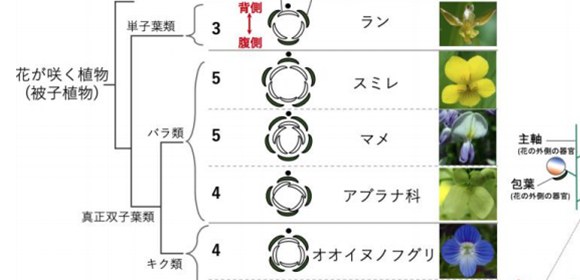
A crop of bilaterally symmetric flowers from inhibitory fields
(Note: The following was originally featured as a Research Highlight in Development at: https://dev.biologists.org/content/147/3/e0303 .)
Flowers are extremely diverse in terms of organ number and arrangement. For example, lilies organise their petals in a radially symmetric pattern whereas other flowers, such as orchids, have bilateral symmetry along the dorso ventral (D-V) axis. Other plants have floral organs with both radial and bilateral symmetry, depending on whether they are lateral or terminal flowers. At a molecular level, some genes are known to be expressed asymmetrically along the D-V axis, such as CYCLOIDEA gene homologues. However, how these factors achieve such diversity of floral organ arrangement is not well understood. Now, Aiko Nakagawa, Miho S. Kitazawa and Koichi Fujimoto apply mathematical modelling to design a principle for floral organ arrangement. Their method is based on a phyllotaxis model of an ‘inhibitory field’, whereby existing organs regulate the position of new organs. In their model, the authors employ two inhibitory fields at the dorsal and ventral side of the floral primordium and, by varying the relative strength of the inhibitory fields and the size of the meristem, they are able to simulate the diverse and complex bilateral patterns observed in different plant species. These results indicate that differences in D-V inhibition can explain the diversity of bilateral symmetry in flowers.
The article, “A design principle for floral organ number and arrangement in flowers with bilateral symmetry,” was published in Development at DOI: https://doi.org/10.1242/dev.182907 .
Related links
